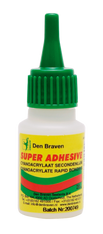ADHESIVES
For adhering materials two methods can be used. Firstly there are mechanical fixings like screws and pop-nails. The second method is using...
Read moreSegments
Technologies
Filter
7 products found
PU Thermo Adhesive B1
Professional B1 adhesive foam for external insulation facade systems

PU Thermo Adhesive B3
Professional B3 adhesive foam for external insulation facade systems

Elast-O-Rub
A versatile non filled sealant

Fix-O-Chem (Styrene Free)
2-component tension free chemical anchoring styrene free

Super Adhesive
Fast super glue

Montagefix-N
Versatile fast setting adhesive

PU Stone Adhesive
High quality ready-to-use stone adhesive

ADHESIVES
For adhering materials two methods can be used. Firstly there are mechanical fixings like screws and pop-nails. The second method is using adhesives.
For adhesive applications, there two different methods of bonding. The craftsman and industry has a choice of hard and non-flexible adhesive or a softer, more flexible type of adhesive. The world of flexible adhesives has experienced a surge in development in recent years. Not only in growing volumes, but also an increased variety of bonding possibilities.
Flexible bonding vs. a mechanical fixing
Why choose flexible adhesive bonding over a mechanical fixture? There are numerous reasons:
• Prevents corrosion
• Prevents dust
• Prevents damages
• Prevents sound transmission
• Prevents sound vibrations
• Absorbsing expansion differences
• Spread of power even spread of load
• Can be repaired
• Reduction in labour costs
In the list above Bostik provides evidence that flexible adhesives are preferable for many “fixing” applications, and outperform mechanical fixtures. Of course there are some disadvantages to adhesives compared to mechanical fixtures. We do not recommend an adhesive if the surfaces are not sufficiently cleaned and/ or dry. The choice to use a flexible adhesive always means weighing up the pros and cons.
Characteristics of flexible adhesives
Den Braven suggests the most important features of flexible adhesives to support you in your product and application choice. Bostik have a unique tool on the website to find the most suitable product for your application. Please follow the hyperlink Product Recommendation Tool.
• 1 component
• Moisture curing
• Skin formation between 5 and 15 minutes
• Curing speed varies from 1 to 5 mm per 24 hours
• Flexible
• Wide adhesion spectrum
Basic technologies
Flexible adhesives used to be made from Polyurethanes. However, in recent years the hybrid based adhesives are gaining more and more popularity. Hybrids can be split into two different technologies: Silylated Urethane based Hybrids and Silylated Polyether based Hybrids. However, these two technologies have tiny differences. These products are recogniszable because they are filled in the standard conventional cartridges instead of the aluminium cartridges for the Polyurethane adhesives. Hybrids in comparison to Polyurethanes are:
• Environmentally friendlier
• Outperform in elasticity and durability
• Higher UV resistance
• Free of the bubble effect due to isocyanates
• Free of dangerous labelling
How to apply adhesives
Bostik always recommends testing prior to the application. Always clean the surfaces to be bonded and ensure that the surfaces are dry. If necessary, degrease the surface thoroughly. Sanding of the surface is generally not recommended as the adhesive may too thick (thixotropic) to fill potential grooves in the surface.
The adhesive should be applied in strips with a diameter of 8 mm. If the bonded area is larger, you will need more adhesive strips. These should be separated by 10 cm up to 40 cm. Where a difference in formation is expected (due to linear movement in the adjacent surfaces), ensure a final adhesive thickness of about 3 mm. Use double sided adhesive foam tape of 3 mm in height.
Once the adhesive has been applied the surfaces can be joined within the specified time frame. This is in order to avoid skin formation due to “drying” of the flexible adhesive. Do not press firmly until the correct position has been achieved. Once correctly aligned press firmly to ensure adhesion to both surfaces.
Due to the chemical process of moisture curing the total curing time may take a longer. Water vapour from in the air will start the curing reaction. This process is relatively slow. The flexible adhesive will cure a few millimetres per 24 hours. If the adhesive does not have access to humidity, the curing time will slow down. For this reason it is very important to apply the adhesive in strips for ventilation and not to apply the adhesive to the entire surface.